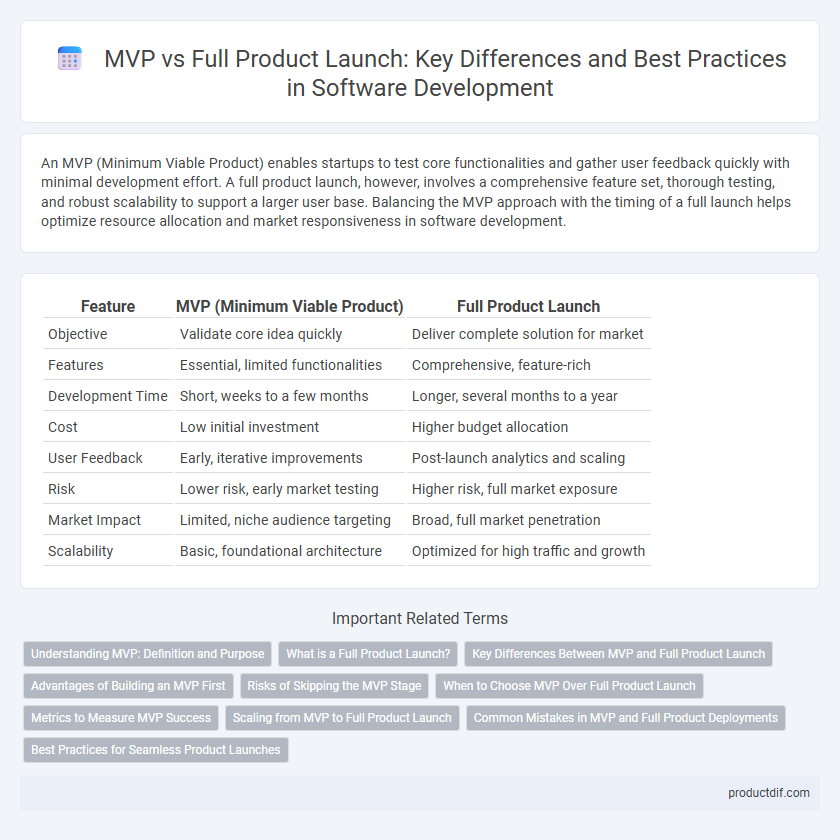An MVP (Minimum Viable Product) enables startups to test core functionalities and gather user feedback quickly with minimal development effort. A full product launch, however, involves a comprehensive feature set, thorough testing, and robust scalability to support a larger user base. Balancing the MVP approach with the timing of a full launch helps optimize resource allocation and market responsiveness in software development.
Table of Comparison
| Feature | MVP (Minimum Viable Product) | Full Product Launch |
|---|---|---|
| Objective | Validate core idea quickly | Deliver complete solution for market |
| Features | Essential, limited functionalities | Comprehensive, feature-rich |
| Development Time | Short, weeks to a few months | Longer, several months to a year |
| Cost | Low initial investment | Higher budget allocation |
| User Feedback | Early, iterative improvements | Post-launch analytics and scaling |
| Risk | Lower risk, early market testing | Higher risk, full market exposure |
| Market Impact | Limited, niche audience targeting | Broad, full market penetration |
| Scalability | Basic, foundational architecture | Optimized for high traffic and growth |
Understanding MVP: Definition and Purpose
An MVP (Minimum Viable Product) is a software version with just enough features to satisfy early adopters and gather essential user feedback. Its primary purpose is to validate core hypotheses, reduce development risks, and guide future product iterations efficiently. By focusing on critical functionalities, the MVP enables teams to test market demand before committing resources to a full product launch.
What is a Full Product Launch?
A Full Product Launch entails releasing a complete, fully functional software solution to the market after thorough testing and iterations based on user feedback. It includes all planned features, robust performance, scalability, and comprehensive documentation to ensure a seamless user experience. This phase typically follows the MVP stage and aims to capture a wider audience and drive significant market adoption.
Key Differences Between MVP and Full Product Launch
An MVP (Minimum Viable Product) focuses on delivering core features to validate product-market fit with minimal resources, while a Full Product Launch offers a comprehensive feature set designed for broad market adoption. MVP prioritizes rapid deployment and user feedback to iterate quickly, whereas Full Product Launch emphasizes scalability, user experience refinement, and robust performance. Key metrics for MVP success include user engagement and feedback quality, contrasting with full launch metrics that track extensive user retention, revenue growth, and market penetration.
Advantages of Building an MVP First
Building a Minimum Viable Product (MVP) first allows software teams to validate core functionalities and gather user feedback with minimal investment, reducing the risk of costly pivots during full product development. Early market entry through an MVP accelerates learning about customer preferences, enabling data-driven enhancements that increase the product's chances of success. This iterative approach improves resource allocation and ensures the final product aligns closely with user needs, enhancing overall product-market fit.
Risks of Skipping the MVP Stage
Skipping the MVP stage increases the risk of misaligned product-market fit, leading to wasted development resources and delayed time-to-market. Without early user feedback, critical usability issues and feature mismatches remain undiscovered, escalating post-launch correction costs. This approach heightens the chance of product failure due to unresolved technical flaws and unmet customer needs.
When to Choose MVP Over Full Product Launch
Choosing an MVP over a full product launch is ideal when validating core features and gauging user interest with minimal investment. MVPs enable quicker market entry, collecting crucial user feedback to guide iterative development and reduce time-to-market risks. Opt for a full product launch only after confirming product-market fit and establishing a validated demand through MVP insights.
Metrics to Measure MVP Success
MVP success is measured by key metrics such as user engagement rate, retention rate, and conversion rate, which indicate product-market fit and validate core features. Tracking customer feedback and bug reports provides qualitative insights to prioritize development in the full product launch. Cost per acquisition (CPA) and time-to-value (TTV) metrics optimize resource allocation and accelerate iterative improvements.
Scaling from MVP to Full Product Launch
Scaling from MVP to full product launch requires robust infrastructure to handle increased user demand and ensure system reliability. Implementing scalable cloud services and automated deployment pipelines accelerates time-to-market while maintaining product quality. Integrating user feedback and analytics during the MVP phase guides feature prioritization and resource allocation for successful full product scaling.
Common Mistakes in MVP and Full Product Deployments
Common mistakes in MVP deployments include overloading the product with features, leading to scope creep and delayed feedback collection from real users. In full product launches, neglecting thorough testing and user experience optimization often results in performance issues and user dissatisfaction. Both stages require clear prioritization and iterative development to balance speed with quality and market needs.
Best Practices for Seamless Product Launches
Launching a Minimum Viable Product (MVP) enables early market validation by focusing on core features, reducing time-to-market and development costs. Best practices emphasize iterative user feedback integration, scalability planning, and robust testing to ensure a smooth transition from MVP to a full product launch. Leveraging analytics and continuous deployment pipelines enhances responsiveness and product stability throughout the launch phases.
MVP vs Full Product Launch Infographic

 productdif.com
productdif.com